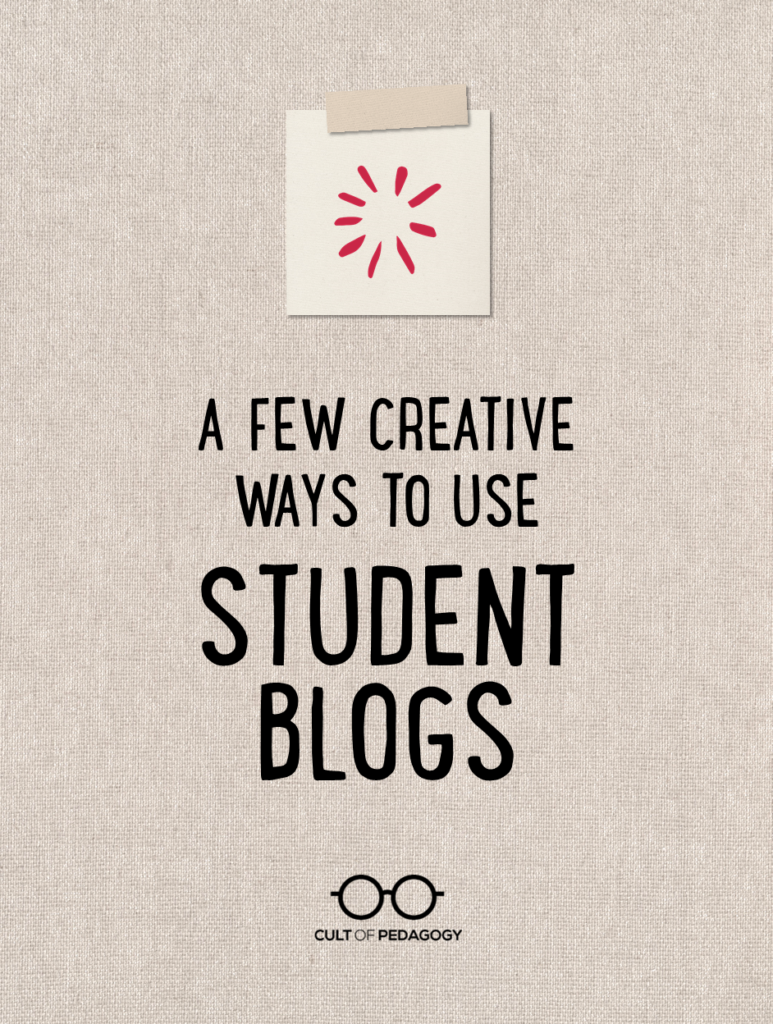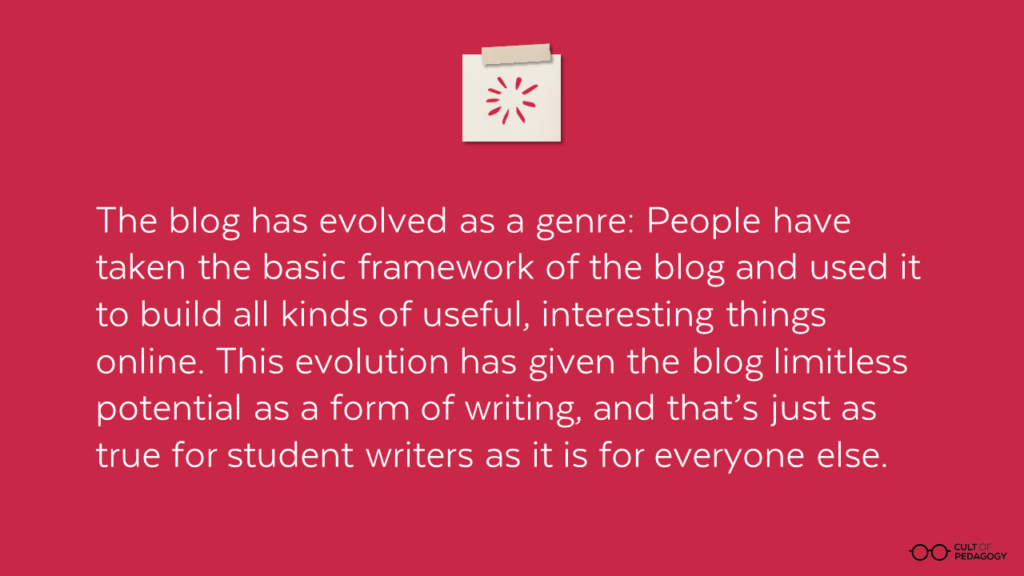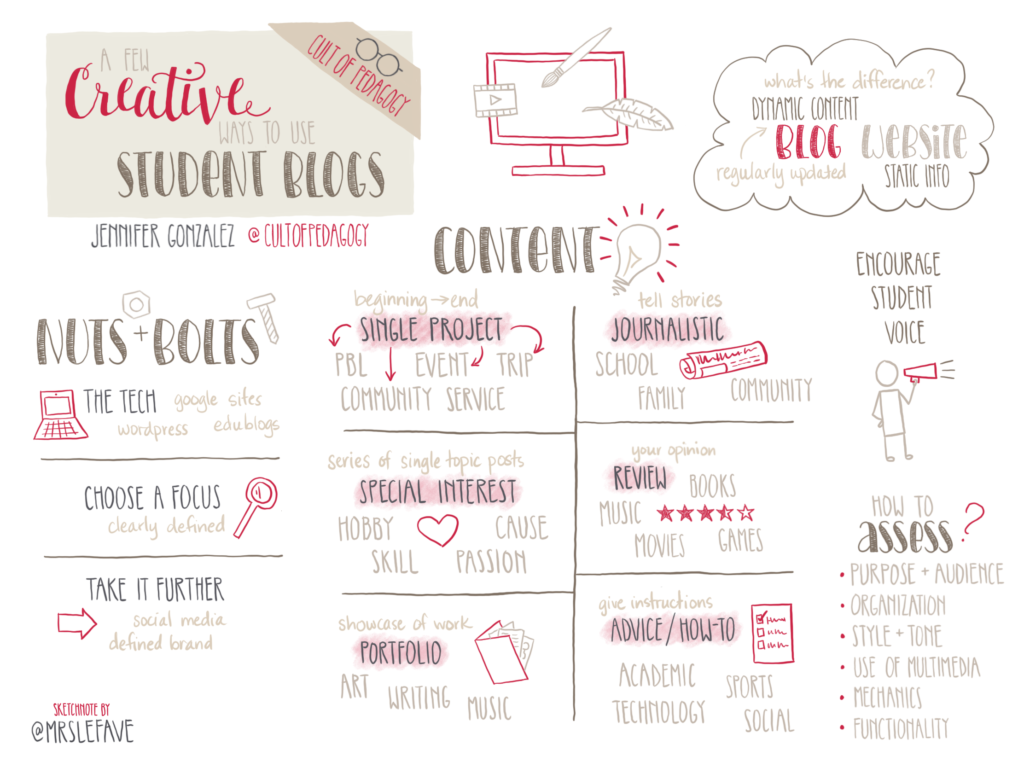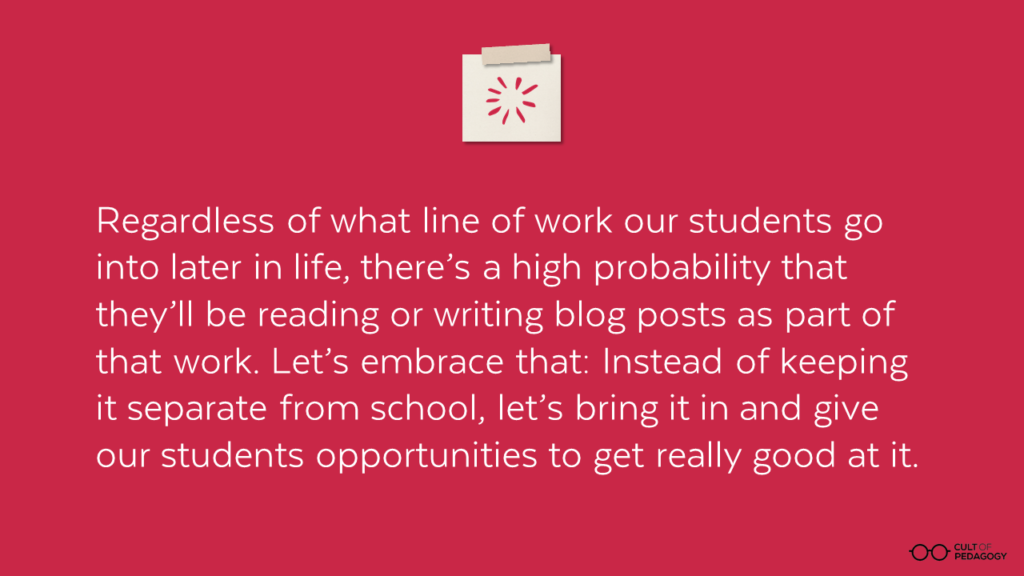
Listen to this post as a podcast:
Sponsored by Pear Deck and ISTE U
When you hear the word “blog,” what do you think of? When blogs first started showing up on the internet, most were basically diaries, individual people’s personal musings on life. Although this is a perfectly legitimate practice, these early prototypes made many of us equate the word “blog” with something self-indulgent, writing that shouldn’t be taken seriously.
Since those early days the blog has really evolved as a genre: People have taken the basic framework of the blog and used it to build all kinds of useful, interesting things online. This evolution has given the blog limitless potential as a form of writing, and that’s just as true for student writers as it is for everyone else. So if you’re looking for a nice, meaty assignment, one that in previous decades might have been a research paper or an oral presentation, consider assigning a blog instead. It’s not only a highly relevant form of writing, but because it’s done entirely online and worked on over time, it would also lend itself beautifully to remote or hybrid learning.
To support you on this mission, I’m going to share six different kinds of blogs students could create, each of which could be written on thousands of topics and fit into plenty of different content areas. I’ll also explore some of the nuts and bolts—tools and practices that will help you do this work well. And finally, I’ll talk about how you might go about assessing student blogs.
Before we get into all that, let’s make sure we all understand our terms.
What’s the difference between a blog and a regular website?
Let’s start by defining our terms. A website is basically any online “container” that houses at least a few pages of content. It’s possible to have a website that consists of nothing but a single page, but usually those exist simply because the people behind them opted not to use any additional features.
Your dentist, most likely, has a website. Most of the restaurants, mechanics, churches, and gyms in your town probably have websites. These sites typically consist of just a few pages: a home page that lists some general information, hours, the address, etc, and then a few more pages that provide more detail on the goods and services offered by the business, the staff, and maybe the history of the place. That’s basically it. All of those pages are more or less static, meaning the information doesn’t change regularly unless something about the organization changes (new staff members, new menu items or services, etc.).
A blog is part of a larger website, and what makes it unique is that it is dynamic. It changes. It’s regularly updated to provide new material. Some companies, like the kinds listed in the previous examples, might decide to add a blog to their regular website for the purposes of educating their clients or helping their customers get to know them. For example, a dentist’s website might put out regular blog posts offering tips on home dental care, reviewing toothbrushes, or sharing before-and-after stories of patients who received special services like laser teeth whitening. In most cases, though, these blogs aren’t chock-full of content because they’re just a supplement to the main thing, which is to give the reader information about the business.

Some websites, like my own, are more heavily focused on the blogging side of things. Yes, my site has a few static pages—like the one where I introduce myself and my staff—but the vast majority of the content on my site is blog posts. These blog posts are not just general musings about life, though. I made the decision when I started my site that it would be focused solely on education-related topics, with the main goal being to write posts that help teachers do their work better. Every other week I put out a new blog post—along with a podcast episode—on a different topic.
The internet is full of sites like mine, websites that use a blogging framework to regularly share content for an audience that will be interested in that specific topic. Most of them wouldn’t even call themselves “blogs.” Instead, they’d see themselves as websites that are content-heavy. Those are the types of blogs I’m focusing on here, the kind I think our students should be writing.
Ideas for Content
What follows are six different ways students could use a blogging platform to produce a collection of content. In many cases, that “content” is writing, but in some cases, it is another type of media. These blogs could be done just for school, but if they’re good, if the students want to, and if their parents give permission, the blogs could ultimately reach a wider audience and might even end up turning into a career.
1. The Single Project Blog
This would be devoted to documenting a project from beginning to end. It would include a description of how the idea came about, any research and planning that happened, progress on the project at different stages along the way, the final result, and impacts or outcomes after the project was over. If your school does a lot of project-based learning or offers a genius hour program or an innovation class, this type of blog would be a natural fit.
Example Topics:
- A community service project, where the student or a group of students is doing something to serve the community
- A learning blog, where the student sets a goal of learning something, like a language, or developing a particular skill, like juggling, and documents progress along the way
- A build of some kind, where the student is creating a specific end product, like a mural, a piece of furniture, an app, a painting, etc.
- Any kind of trip or journey taken by the student or a group of students
- A performance or event, like a play, talent show, ceremony, or celebration
2. The Special Interest Blog
What are your students passionate about? This type of blog features an ongoing series of posts around a single topic. Ideally, the topic will be broad enough so that it can include some sub-topics as well. This type of blog would be a good fit for a social studies or science class, if you wanted students to focus on a topic related to your content area.
Example Topics:
- A hobby, like skateboarding, gaming, traveling, any kind of music (as a player or spectator), or any sport (as a player or spectator)
- A cause, like environmentalism, racial justice, or animal welfare
- A historical period, event, place, or person
- A country or culture
- A skill area like cooking, woodworking, gardening, or any type of craft
- A health-related topic like nutrition, exercise, sleep, or mental health
- A musical artist, celebrity, movie franchise, or TV show.
3. The Portfolio Blog
This is designed to showcase a collection of the student’s work in one particular area. Along with each artifact, the student could also write an introduction or reflection on the piece to give insights into the creation process or their inspiration for the piece.
Example Topics:
- short stories, poetry, chapters of a novel or memoir
- art (either digital art or photographs of paintings, hand-drawings, sculptures, and other mixed media)
- photography
- comic strips or graphic novel-style stories
- video
- music

4. The Journalistic Blog
Like a magazine or newspaper, the goal of this type of blog would be to tell stories about things that are happening now. These stories can include photos or videos to supplement the writing, or they can be focused mainly on photos or videos with minimal text. Stories can be short and “newsy” or longer, magazine-style feature articles.
Example Topics:
- school-related news, either general or narrowed down to a specific angle, like sports, the arts, or even specific clubs
- community news, either general or focused more narrowly on specific neighborhoods, interests, or businesses.
- family news: Ideal for students who belong to large families where keeping up with individual family members’ milestones and life changes would help the whole family stay connected
5. The Review Blog
This type of blog would be comprised solely of reviews, where the writer (or group of writers) review new or established offerings in a particular category.
Example Topics:
- music
- movies or TV shows
- books
- restaurants
- video games
- websites
- videos on TikTok, YouTube, and other platforms
6. The Advice or How-to Blog
On this type of blog, the writer would simply give advice or instructions on how to do things. The topics could come from real readers, or the site creator could just make them up based on common problems they know people have.
Example topics:
- relationship or friendship advice or how-tos
- academic advice or how-tos
- hobby or sports-related advice or how-tos
- technology how-tos
Nuts and Bolts: Making it Work
The Tech
Choose a platform where students can build their blogs.
- WordPress is my recommendation if students want to use a well-established platform for free.
- Google Sites and Blogger are also free and may be easier, but they don’t offer as many features as WordPress.
- Edublogs is a good option for younger students, because it gives teachers more control over student blogs, privacy, etc.
- Some sites have age restrictions that do not permit users under a certain age, so be sure to check the Terms and Conditions and consult with your district IT department before launching a blogging project.
Choosing a Focus
Just like with a research paper or a presentation, a good blog will have a clearly defined focus. Here are some considerations:
- Many of the types of blogs listed here can be combined. A special interest blog might regularly feature posts that give reviews of products, for example. A portfolio blog might occasionally feature a how-to post about the skills being showcased.
- When choosing a topic, consider the target audience. Who are students writing for? Even if the blogs will not actually be shared with the public due to student age or general privacy concerns, students could still write for a hypothetical audience.
- Any of these blog types can have a personal angle if the writer chooses. Letting an audience get to know you as a person can make your writing much more compelling, and this kind of writing not only helps the writer reflect and grow personally, it can also be helpful to readers who connect with those experiences.
- One good way to determine whether a chosen focus is a good fit is to create a list of blog post topics ahead of time. If a student can’t come up with more than a few ideas, the topic might need to be broader. For example, if a student wants to write about skateboarding gear and doesn’t have many ideas for posts, it might make more sense to write about skateboarding in general; this will allow for more diversity in topics under that larger umbrella.
- It is possible for a person to have more than one blog at a time or multiple blogs over time. Not that you’d assign more than one, but knowing this and letting students know might help when they’re trying to decide on a topic and can’t choose just one. (By the way, it would be better to have two separate blogs on two different topics than trying to force them together on one site.)
Taking it Further
Students who want to go beyond school with their blogs might consider these add-ons and tips:
- Most blogs have social media accounts associated with them. This helps writers advertise new posts and build an audience. Many blogging platforms have tools built-in to link the blog to social media accounts, so readers can find your Instagram or Twitter feed from your blog, and vice versa.
- It’s also a good idea to have a clearly defined brand—this includes things like the blog title and tagline, the colors and typefaces you use for your blog design, the artwork you add to supplement your posts, even the kind of language you use in your writing (Is it formal? Casual? Does it include a lot of slang from the audience you’re speaking to?) This branding should be consistent in your social media as well.
- It’s possible to monetize most blogs if students have the desire, the drive, and the permission to do so. This revenue can come from advertising, from selling products through other sites like Etsy, eBay, Amazon, and others, or from affiliate marketing, where the blogger receives a commission for recommending products sold by other people.
- For a blog to be successful, it’s important to maintain a consistent schedule of posting—even if that’s once a month. Your readers will come to expect whatever schedule you set for yourself, and if you’re all over the map in your posting, that will make it harder to grow an audience.

Assigning and Assessing Student Blogs
Ideally, a student blog would be a long-term assignment, where students must come up with an idea and develop it over time, “submitting” the final blog for a grade, but getting a lot of feedback from you along the way as different posts are published.
When assigning a blog it’s important to define the criteria by which you’ll assess it. I strongly recommend you use a single-point rubric for assessing blogs; share the criteria with students ahead of time or better yet, co-construct the criteria with them.
Below are some criteria I think would be important to include in a rubric for student blogs. I’m sure there are many excellent blogging rubrics out there that address some characteristics I haven’t thought of, but this is what I have so far:
- Purpose and Audience: The overall focus is clearly defined and consistent throughout the blog. Individual blog posts have a clear focus that is consistent with the larger theme. The writing is directed toward a targeted audience that is consistent across individual posts.
- Development: The overarching topic of the blog is developed with posts that address sub-categories. Each individual post addresses a clear, specific idea and develops that idea with sufficient details.
- Organization: Posts are organized effectively with categories and tags, making it easier for readers to find what they’re looking for.
- Style and Tone: All posts are written in a style and tone that is appropriate for the audience.
- Effective use of multimedia: The writing is enhanced with images or video that expand on the content or relate to it in some way.
- Ethical and appropriate use of multimedia: Images, video, or music use complies with copyright and fair use laws. Appropriate credit is given to creators of other works. (See this post for more information.)
- Writing mechanics: Errors in spelling, grammar, punctuation, and usage are infrequent and do not distract from the overall experience of reading and understanding blog posts.
- Technical functionality: All features of the site operate correctly to create a seamless, pleasant reading experience for readers. Links work as expected, elements that appear “clickable” work properly, and nothing from the “back end” (such as HTML coding that should not be visible to the user) shows up on the site.
It’s often said that people don’t read and write anymore, that all we do is mess around on our devices. But I think we’re still reading and writing all the time; the delivery systems have just changed. And one of the most popular delivery systems in the 21st century is the blog. Regardless of what line of work our students go into later in life, there’s a high probability that they will be reading or writing blog posts as part of that work. Let’s embrace that: Instead of keeping it separate from school, let’s bring it in and give our students opportunities to get really good at it.
Join our mailing list and get weekly tips, tools, and inspiration that will make your teaching more effective and fun. You’ll get access to our members-only library of free downloads, including 20 Ways to Cut Your Grading Time in Half, the e-booklet that has helped thousands of teachers save time on grading. Over 50,000 teachers have already joined—come on in.





Hello Jennifer,
Greetings from Brazil!
I love your newsletter and your blog. Thank you for the material! I teach in Legal Courses and they are very useful. Last year I cited one of your posts in a book that I wrote with a colleague.
I think it would be great to mention Medium as another online resource to publish students’ works (at least in Higher Education). =)
Keep doing this great job!
Thanks for sharing this, Guilherme!
I love that you agonized over whether to use “criteria” or “criterion”! Thanks for this and all your podcasts. They have allowed me to think creatively about teaching during a pandemic instead of just being filled with fear and dread.
Hi Jennifer,
I always love the idea of bringing the real world into the classroom, and blogs can certainly do that for students–especially if they have good examples that will motivate their own work. One thing to be careful of, however, is the fact that everything a student posts will be online for anyone to see forever, unless they take it down. That means that the idea they thought was cool when they were 15, or that controversial opinion they held when they were figuring out who they were, will be available to colleges, future employers, or just future classmates. Students should definitely be warned of this and given the opportunity to write about topics they’re still figuring out in a private setting (that could still be imitating the blog style).
Hi Dave! These are all great points – thank you! There are several places throughout the post where Jenn mentions that blogs can be done just for school and that they don’t need to be shared with the public. There’s also a section that addresses privacy and age requirements. Even so, these are really important digital citizenship discussions to have with students whenever they are sharing anything online. Thanks again!
This post rocks! Thank you so much for inspiring and informing so thoroughly! I teacher at a small charter school in northern Cali and I look forward to using student blogs as we go all online.
Thank you so much for this post, it really has me thinking about how I could use blogs in my classroom. Even though this post may be directed to older students I can see potential in using blogs with my Grade 3 classroom. I have traditionally used portfolio’s to highlight projects we have completed in the classroom and a blog might be the way for us to continue to have a portfolio but online. I am wondering if you or anyone else has used blogs with this young of an age group and if you have any tips or tricks in helping them develop it? I am fairly new to the blogging world but like the idea of having a place for students to highlight and reflect on their work. Thank you so much for any insight you have to share!
Hey Michelle,
Check out these articles and see if they offer any ideas that you might want to try:
10 Blogging Activities For Elementary Students
Blogging? It’s Elementary, My Dear Watson!
Epic Classroom Blogging with Elementary Students
Kidblog
Hope this helps!
I would like to have my students try writing a special interest blog this semester during remote learning. I am trying to find appropriate models for them to look at as an introduction to blogging, but I am having trouble finding ones that are good models but are not too sophisticated or professional-looking (which will probably intimidate them). Do you happen to have any examples that may point students in the right direction?
Hi Alana,
You can find student and class blogs on the internet, but because they’re all vastly different, it would be hard to know which, if any, would resemble what you might be looking for. Honestly, my suggestion is to use Backward Design to create your assignment and then Dogfood your assignment. That is, go ahead and create your own special interest blog as if you were a student. That process will help you figure out where you need to make adjustments in your lesson and fine-tune the requirements, rubric etc. The blog that you end up creating would really be the best model to share with your students. Hope this helps!
I’m entering a blogging unit with my students, which we are kind of developing on the fly as a result of hybrid learning. I’m interested in any models that teachers are using with their students. I have teacher model that I’m developing along side my students and there are a few professional blogs that I’ve used with my students. However, I find, with this kind of thing, the more models the better as they help inspire students by giving them ideas of what kind of work is possible.
Hi Nathan,
Take a look at Edublogs support page – it takes you through a step-by-step process for setting up student blogs. Hope this helps!
I learned in “Creative Ways To Use Blogging,” that this form of communication has evolved and expanded so that it is a useful tool for students. I actually didn’t understand the difference between a blog and a website until I read the article.
Because my school is slated to become a project based school, I like the idea of a portfolio blog for my kids because it allows them to track their progress over a long period of time. As well, the single project blog is one that I’m going to start my kids on now, because it’s great for the novel we are about to read. I think/hope it will motivate my students to take control of their own learning.
This article/podcast was very helpful! As a student teacher, I am always looking for new ways to integrate technology into the classroom because it increases student engagement and promotes differentiation. I am going into English teaching, and I love that blogs give students a real-world writing situation where they understand the “why” of writing and are not simply writing for the teacher or peers.
As I listened to your ideas, I couldn’t help but apply them to the English classroom specifically. I think blogs, in addition and in connection to what you have already said, can be used to gather background information about a novel, function as a writer’s notebook, or post book reviews about choice/class novels. In addition, the “how-to” blog could work as a formative assessment for students to explain grammatical principles or literary devices in their own words before being assessed in a summative manner.
Thank you for such a great podcast! It was enlightening to hear your ideas.
Glad you enjoyed the post, Hailey!
Hi!
I am just starting to research and look into how blogging can be used in my classroom. You have provided so many different avenues to choose from! I am so grateful. I would like to start with using a single project blog to get our feet wet (myself and my students). I am an emotional support teacher and I would love to have students choose a goal to work towards during our SMART Goal unit and track their progress, feelings, and thoughts throughout the unit and school year. Thanks again for all of the ideas!
So glad you enjoyed the post, Courtney! And thanks for sharing with others who might be interested.
Hi Jennifer,
Thanks for all the great student blogging project ideas. I look forward to reading your posts and finding fun ways to engage students in the classroom. I used your idea of the Special Interest Blog for a graduate class and look forward to implementing it in my classroom. Keep Blogging!
-Kristy Herr
Hello!
Thank you so much for all the blogging ideas! I am currently in a grad class looking for student blogging projects to use in my orchestra classroom, but was coming up with very little results. Using your Portfolio Blog idea, I think I came up with a project that could be relevant to my class. You can check out my full idea here: https://ekumpf.edublogs.org/2021/11/13/student-blogging-performance-reviews-in-the-orchestra-class-bceol-la-3-3/
This is awesome and I love it. I feel like academic writing such as the Five Paragraph Essay is becoming more and more obsolete. When students reach the “real world” very rarely will they need that kind of writing. BUT this format really lends itself to many different avenues of use. I’m ditching the essay in favor of trying this type of writing. They can still use text evidence, do citations etc. I’m excited and hope it will capture the interests of my students.
Thank you for this. It has helped me in my planning.
Thank you for sharing, Erin. Jenn will so glad to hear you found it useful!
Greeting from Rochester, NY
Thanks for providing a variety of example of how we can use blog.
I am a bilingual math teacher, this article provide a wide variety of examples, that I hope to use with my students.
Portfolio and artifact took my attention.
Do you have any picture or examples of mathematics problems ?
Thanks
Hi, Carolina! Cult of Pedagogy has an entire Pinterest board on teaching math that may provide some inspiration about the types of math problems your students could include as artifacts in a portfolio-style blog. A couple that might be helpful are this post from Maneuvering the Middle that offers math project examples and this one that discusses the benefits of numberless word problems. I hope this helps!
I loved your idea about having students create a blog to follow their journey with community service. Having them include an “impact of their project” section at the end really ties together their journey and allows for self-reflection. My students are required to complete 10 hours of community service for graduation and I think would benefit from a project like this. Do you have any sources for examples of actual student-created blogs pertaining to community service? I would love to see what they created.
I’m creating a blog for my grad class where I share ideas about using blogging in the classroom and would love to include some examples. Here it is so far if you wanted to take a look! https://jer503131.edublogs.org/
Thanks for sharing, Jessica! If you scroll up to the section of this post called 1. The Single Project Blog, Jenn links to this post summarizing her interview with Don Wettrick. That post links to Don’s YouTube channel where he has shared video logs that document his students’ work on a variety of projects.
If you’re looking for additional ideas or information about student blogging in the classroom, you may want to check out this post from John Spencer or this post from Matt Miller. I hope this helps!
It’s fantastic. I believe that academic writing, like the five-paragraph essay, is becoming less and less relevant. Very rarely will pupils require that kind of writing once they are out in the “real world.” HOWEVER there are a lot of alternative ways to use this format. Instead of writing an essay, I’m going to try this style of writing. They are still permitted to cite sources and use written evidence. I’m thrilled about it and am hoping that my classmates will be as well. For this, I’m grateful. I’ve found it useful for planning.
We’re glad to hear you found it useful! Thanks for sharing your thoughts.
Thank you for sharing examples of how students can blog in the class.
Inspirational and informative! Excited to integrate student blogs into our online curriculum at a small charter school in northern California.